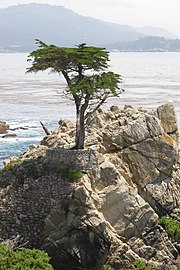Last weekend was Fantastic!!
After a long long time, we had a break!!
We didn't actually plan anything for the trip and everything happened just like that!!
We headed to Monterey after lunch on Saturday.
After an hours drive we reached the place and we made a stop at the visitors centre to see if anything was worth seeing around apart from the famous AQUARIUM.
The climate was totally different when compared to San jose. It was cloudy and nice and I was determined to spend the night there no matter what!!
So having decided on that , we wanted to make sure if there were any other attractions around.
That evening we walked around one of the beaches and then headed off to book a hotel and purchase some basic ammenities for the night.
ABOUT MONTEREY BAYMonterey Bay is a bay of the Pacific Ocean, on the coast of California, south of San Francisco, between Santa Cruz and Monterey, CA. The roughly semicircular bay is ringed by a segment of State Route 1 which connects Santa Cruz at the north end to Monterey at the south end.
Monterey Bay is home to many species of marine mammals, including sea otters, harbor seals, and bottlenose dolphins; as well as being on the migratory path of Gray and Humpback Whales and a breeding site for elephant seals. Many species of fish, sharks, mollusks such as abalone and squid, birds, and sea turtles also live in the bay. Several varieties of kelp grow in the bay, some becoming as tall as trees, forming what is known as a kelp forest.
The Monterey Canyon, one of the largest underwater canyons in the world, begins off the coast of Moss Landing, exactly in the center of Monterey Bay. In 1992 the Monterey Bay National Marine Sanctuary was created, protecting over 4,000 square nautical miles (14,000 km²) of the bay and the surrounding ocean.
Courtesy: Wikipedia
The next day we headed to visit the famous
AQUARIUM.
MONTEREY BAY AQUARIUMThe Monterey Bay Aquarium, which is located on the site of a former sardine cannery on Cannery Row in Monterey, California, is one of the largest aquariums in the world. It has an annual attendance of 1.8 million and holds 35,000 plants and animals representing 623 species.
Among the aquarium's numerous exhibits, two are of particular note.
The centerpiece of the Ocean's Edge wing is a 33-foot (10-m) high tank
for viewing California coastal marine life. In this tank, the aquarium was the first in the world to grow live California Giant Kelp
using a wave machine at the top of the tank (water movement is a
necessary precondition for keeping Giant Kelp, which absorbs nutrients
from surrounding water and requires turbidity), allowing sunlight in
through the open tank top, and pumping in raw seawater. The second
exhibit of note is a one million gallon tank in the Outer Bay Wing
which features one of the world's largest single-paned windows (crafted
by a Japanese company, the window is actually four panes seamlessly
glued together through a proprietary process).
Sealife on exhibit includes stingrays, jellyfish, sea otters, and numerous other native marine species, which can be viewed above and below the waterline. For displaying jellyfish, the MBA uses an aquarium called a Kreisel tankwhich creates a circular flow to support and suspend the jellies.
Visitors are able to inspect the creatures of the kelp forest at
several levels in the building.
Courtesy : wikipedia
Click on the links for :
Map of the Aquarium
Gallery Exhibits
Highlights of the Trip
- We were able to see some of the Feeding shows of the day: Kelp Forest Feeding & sea Otter Feeding.
- We watched an interactive show in the auditorium that lasted for 25 minutes.
- JellyFish Exihibts were awesome!!
- Purchased an Art piece that has a jellyfish blown inside a glass. the speciality is it glows in the dark!!! (caution: no direct sunlight!)
For More information about the Aquarium visit their Home page of the Aquarium
This tour lasted for about 3 hours after which we had our lunch and headed off to the 17 Mile Drive.
17 Mile Drive
From Wikipedia, the free encyclopedia
The
17 Mile Drive is a scenic road through Pacific Grove and Pebble Beach, California, United States, much of which hugs the Pacific coastline and passes famous golf courses and mansions. It also serves as the main road through the gated community
of Pebble Beach. Like the community, the majority of 17-Mile Drive is
owned and operated by the Pebble Beach Corporation. This corporation is
currently owned by Plaut Inc. Entry into Pebble Beach costs US$9.25 per
automobile. Residents of Pebble Beach and their guests enter for free.
Entry is also free for bicy

clists and pedestrians. Motorcycles are prohibited from entering 17-Mile Drive.
At the north end, the road originates in Pacific Grove at the
intersection of Del Monte Blvd and Esplanade Street. The famous portion
of 17-Mile Drive then begins a few miles south of this point. Where Highway 68 (Holman Highway/Sunset Drive)
crosses 17 Mile Drive marks the entrance to Pebble Beach. The road runs
inland past Spanish Bay, then adjacent to beaches and up into the
coastal hills, providing scenic viewpoints. Travel along 17-Mile Drive
takes as long as the traveler likes, a minimum of 20 minutes to Carmel
without stops. There are numerous turnouts along the road to stop, take
pictures, or get out and stroll along the ocean or among the trees.
Visitors receive a map that points out some of the more scenic spots.
Chief among these is the
Lone Cypress Tree, the official symbol of Pebble Beach and a frequent fixture of television broadcasts from this area.
In 1990 the Monterey Journal reported that Pebble Beach's lawyer, Kerry C. Smith, said "The image of the tree has been trademarked by us," and that it intended to control any display of the
cypress for commercial purposes. The company had warned photographers
that "they cannot even use existing pictures of the tree for commercial
purposes.
The only services open to the public in Pebble Beach (gas stations,restrooms, restaurants) are at the Lodge at Pebble Beach and the Inn at Spanish Bay; there are plenty of comfortable and scenic spots to picnic. Spyglass Hill and Poppy Hills golf courses also have restaurants open to the public.Just outside the Pacific Grove 17 Mile Drive entrance to the gated community of Pebble Beach is Pacific Grove's Sunset Drive (which becomes Ocean View Boulevard) and follows Pacific Grove's scenic coastline and is called by some the "poor man's 17-Mile Drive."
Click here for INTERACTIVE MAP
The road then passes through the Pacific Road Gate and enters the start of 17-Mile Drive proper.
Car drivers have to pay for the privilege ... but cyclists are free and can smugly overtake the line of cars at the pay booth.
The road then sweeps around Spanish Bay, through woods, past the junction with Old 17-Mile Drive and on out to Point Joe.

Next stop after Point Joe is Bird Rock. This lives up to its name supporting thousands of cormorants.
Along this section there are some seriously smart houses.

Older houses were being bought up, demolished and replaced by more modern designs.
After Bird Point comes Seal Point.
Yes you've guessed it ... home to lots of seals.
A short section of the foreshore was cordoned off by a six foot high fence intended to give the seals some privacy whilst pupping.
We passed the first of numerous golf clubs ... Monterey Peninsula Country Club, Spyglass Hill Golf Course, Cypress Point Golf Course.
The trail then climbs away from the shoreline into a thick grove of Cypresses.
Hidden among the trees are expensive mansions surrounded by manicured gardens.
The trail, still buried in the trees, skirts around Cypress Point and then turns south eastward.
This grove contains the largest and oldest Monterey Cypresses in the world.
The twists and turns of the road yield occasional glimpses of the sea down below.
A further kilometre on We arrived at the
Lone Cypress®.

'Lone Cypress is the corporate logo and trademark of Pebble Beach Company'.
'As such, the use of the tree's image is regulated by law. ...
Photographs ... for personal use only are welcomed'.
The small parking lot by the Lone Cypress was swarming with visitors.
The mansions along this section of the road are even more expensive and elaborate than the ones further north.
We next arrived at Pescadero Point at the southern point of the
peninsula.
This offers views southward to Carmel .There is currently a proposal cut down around 17,000 trees in the rare coastal forestland at Pebble Beach in order to construct a new golf course and to expand two luxury resorts.The California Coastal Commission is against the plan which is backed by high profile celebrities such as Clint Eastwood and Arnold Palmer.
After Carmel GateWe left 17-Mile Drive we took the highway 1 exit and headed off home.
The Trip was overall marvelous!!
Don't miss this place when you head to California.




